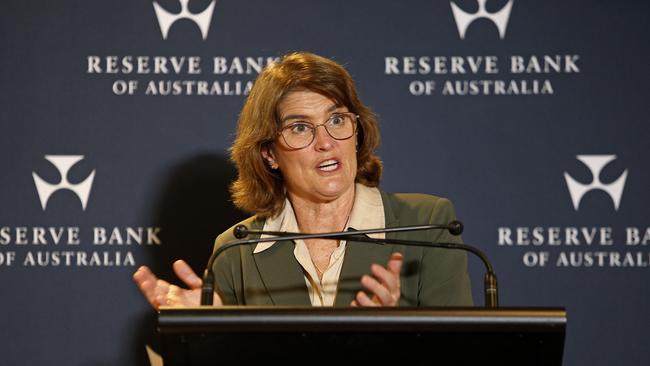What could shift views on Australian interest rates?
A year-end rate cut by the RBA will depend on inflation and household spending data next week.

It was a big week for markets as bond yields soared to multi-month highs after strong US economic data in recent weeks, and Donald Trump’s rebound in opinion polls continued.
With the S&P 500 retreating from record highs the Australian market followed suit.
For the first time in five months, the S&P/ASX 200 fell two weeks in a row as the rise in yields on “risk-free” government bonds fuelled worries about stretched valuations in the sharemarket.
But while the November 5 US presidential election is just around the corner, Australian financial markets will turn their attention to domestic economic data next week.
It’s an outside chance but if underlying inflation comes in lower than expected it could be a game changer for domestic markets, hitting the Aussie dollar and bond yields and boosting shares.
A year-end rate cut is already a long shot after stronger than expected jobs data in recent months, and the quarterly CPI in particular will make or break the case for early rate cuts.
It was a popular view some months ago as other central banks started cutting.
However, the market-implied chance of a cut by December has shrunk to less than one in four.
Even a cut by the next Reserve Bank board meeting in February is now less than fully priced in.
A full 25 basis point cut in the official cash rate isn’t widely expected by traders until April.
Back in early August, the market was expecting the RBA to cut rates by at least 1 percentage point by the end of 2025. Now the market has only 60 basis points priced in over the next 12 months.
Six months ago all of the big four banks were expecting the RBA to start cutting by November. However, the consensus shifted out to February some months ago as inflation proved sticky, jobs data came in stronger than expected and the RBA turned decidedly hawkish.
The RBA hawkishness appeared to peak in August as the board stopped discussing the case for a rate hike in September and stopped suggesting that near-term rate cuts were “unlikely”.
Since then the September jobs data came in much stronger than expected. But about 70 per cent of jobs created in the past year were “non-market” jobs that don’t necessarily reflect underlying economic demand. Demand for other kinds of jobs may be a better guide.
Only CBA is still expecting a year-end rate cut. That’s based on its forecast that the September quarter CPI data will show underlying “trimmed mean” inflation fell to 0.7 per cent on a quarter-on-quarter basis.
After a 0.8 per cent rise in the June quarter, that would give a six-month change of 1.5 per cent, implying that inflation is “annualising” at the top end of the 2-3 per cent target band. “All eyes for domestic financial market participants next week will be on the CPI data,” said CBA head of Australian economics, Gareth Aird.
While a host of monthly consumer prices gauges already released over the September quarter point to a “firming disinflationary pulse” in Australia, it will be up to the official CPI data to confirm that has indeed been the story, according to Mr Aird.
“If our forecast for underlying inflation comes to fruition we expect the narrative around inflation being both too high and ‘sticky’ in Australia to lessen,” he said.
“But like all impending economic releases there is uncertainty around where the data will land.”
CBA’s call for the RBA to start normalising the cash rate in December is now completely reliant on the September quarter trimmed mean CPI rising by 0.7 per cent per cent or less.
“An outcome higher than our forecast will see us jettison our call for a rate cut this calendar year,” Mr Aird said.
Bloomberg’s consensus forecast is for all-important trimmed CPI inflation to remain at 0.8 per cent versus the previous quarter, which would lower the annual rate from 4.1 per cent to 3.6 per cent. Anything higher than that could see some economists push out their rate cut calls well into 2025.
A quarterly trimmed mean CPI increase in line with the consensus would see the six-month annualised rate of trimmed mean inflation fall to 3.3 per cent – a little above the band.
Such a fall in trimmed mean inflation would be unlikely to convince the RBA to cut this year.
“A trimmed mean rise of 0.6 per cent or less on-quarter would make a rate cut this year possible, depending on how the rest of the data print,” said ANZ head of Australian economics, Adam Boyton.
“But given the global direction of inflation and interest rates, an upside surprise of an equivalent magnitude is unlikely to see an interest rate increase from the RBA but may delay the start of the easing cycle.”
The CPI isn’t the only important piece of domestic economic data ahead of the RBA board’s November 5 interest rate decision on Melbourne Cup Day.
On Thursday the ABS will publish September retail trade and an estimate of the volume of retail sales over the September quarter. The following day the official statistician will release the September monthly household spending indicator.
“These two publications will provide the clearest signal yet on how consumers have reacted to the tax cuts with respect to consumption,” said CBA’s Aird.
“Our expectation is that the consumer response has so far been muted, the upshot being that savings have lifted over the September quarter.”




To join the conversation, please log in. Don't have an account? Register
Join the conversation, you are commenting as Logout